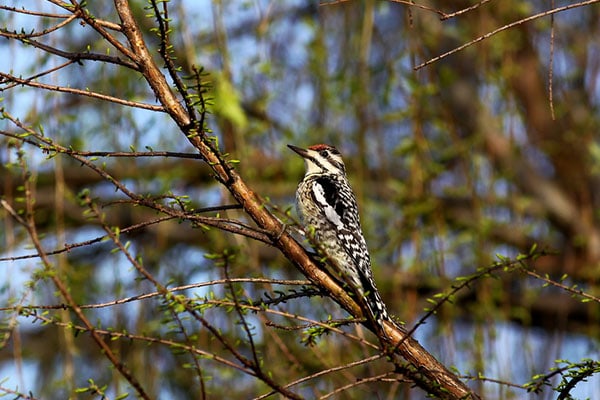Contents
- Yellow-bellied sapsucker facts
- Yellow-bellied sapsucker: how-to identify
- Yellow-bellied sapsucker bird vocalization
- Where You’ll See Yellow-bellied Sapsuckers
- Yellow-bellied sapsucker diet
- Yellow-bellied sapsucker nesting
- Yellow-bellied sapsucker behavior
- How-to attract yellow-bellied sapsuckers
- Yellow-bellied sapsucker threats
- Yellow-bellied sapsucker fun & interesting facts
- Yellow-bellied sapsucker related species in this family
If you’ve ever walked through the forest and noticed a row of shallow holes in tree bark, you should know that that’s the work of a Yellow-bellied Sapsucker. As their name implies, these birds lap up the leaking sap and trapped insects inside the tree trunks, creating these rows of small holes.
In this article, we will learn more about Yellow-bellied Sapsucker. We’ll discuss:
- How to identify them
- Where you’ll find them
- What they eat
- How they nest
- Their behaviors
- How to attract them
- Their conservation status
- Interesting facts
So if you want to learn more about these birds, read on as we go through all the bird facts…
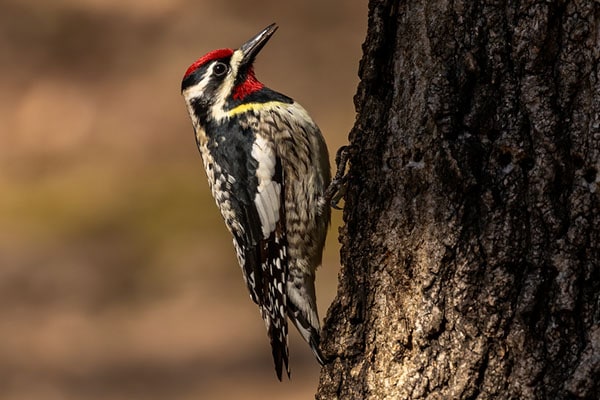
Yellow-bellied sapsucker facts
- Common Name: Yellow-bellied Sapsucker
- Scientific Name: Sphyrapicus varius
- Scientific Family: Picidae
- Life Span: 6.7 years
- Size: 7.1 to 8.7 inches
- Wingspan: 13.4 to 15.8 inches
- Weight: 1.5 to 1.9 oz
- Conservation status: Low Concern
Yellow-bellied sapsucker: how-to identify
Yellow-bellied Sapsuckers are robin-sized woodpeckers with short and straight bills. They grow at 7.1 to 8.7 inches in length, around 1.5 to 1.9 ounces in weight, and have a wingspan of 13.4 to 15.8 inches.
These birds feature a primarily black and white plumage that somehow looks messy. Their backs are black with white patterned bars, yellowish breasts, and white lower bodies with brownish patterns.
The birds also have a red forehead, and there’s a noticeable long white stripe along each folded wing.
Differences Between Male & Female
Male Yellow-bellied Sapsuckers differ from the females because of one feature – they have red throats while the females have white ones.
Differences In Summer Plumage vs Winter Plumage
Yellow-bellied Sapsuckers look the same all year round, regardless of the season.
Yellow-bellied sapsucker bird vocalization
Where You’ll See Yellow-bellied Sapsuckers
Yellow-bellied Sapsuckers are widespread in North and Central America. Their breeding range from Alaska to Canada, and they winter in eastern parts of the United States, Mexico, and Central America.
These birds live in various habitats, including young forests, forest edges, woodlands, and aspen groves. In summer, they prefer to stay in mixed coniferous and deciduous woods, specifically around aspens and other fast-growing trees ripe for sap wells.
Yellow-bellied Sapsuckers are short to long-distance migratory birds that breed in Alaska to Canada around May. They then winter down south to Mexico, West Indies, and Central America around October, sometimes leaving their breeding ground in September.
It has also been noted that female Yellow-bellied Sapsuckers often travel further than south than males.
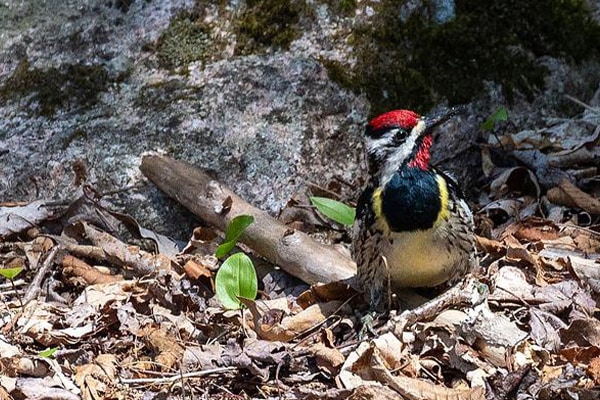
Yellow-bellied sapsucker diet
Yellow-bellied Sapsuckers, as the name implies, rely on sap as their primary food source. They drill wells into trees around early Spring to feed on sap. Holes are often lined in a row, a familiar pattern you’d see in every tree you pass through.
These birds tend to choose sick or wounded trees for drilling sap wells. They also select tree species having higher sugar concentrations, including paper birch, yellow birch, maple, and hickory.
Occasionally, these birds also eat insects when needed as a source of protein. But unlike most woodpeckers, Yellow-bellied sapsuckers don’t prefer this kind of diet.
The birds are also attracted to orchards, where they can also feed on fruits.
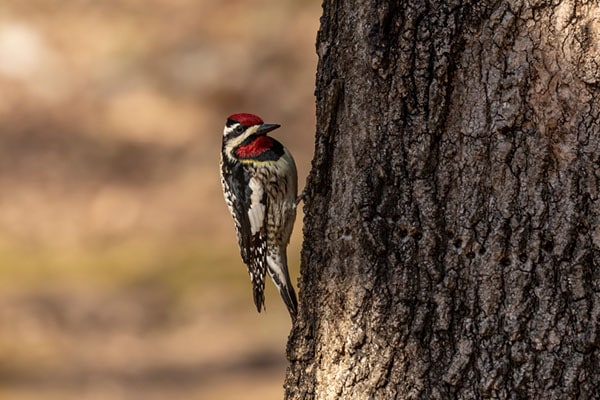
Yellow-bellied sapsucker nesting
- Clutch Size: 4-6 eggs
- # of Broods: 1 brood
- Incubation Period: 10-13 days
- Nestling period: 25-30 days
- Egg Description: White
Yellow-bellied Sapsuckers nest in the same tree species where they also get food. This includes aspen, birch, maple, elm, and beech trees.
These birds don’t choose healthy trees, but they don’t select trees that are dead either. Instead, they nest on live trees that are usually infected with fungus. This way, the heartwood already starts to decay and the excavation process would be easier and faster.
Excavated cavities are often made by males and take around 2-3 weeks to be fully excavated. These nesting sites are only lined with wood chips, have an entrance of around 1.5 inches in diameter, and are 10 inches deep.
Yellow-bellied sapsucker behavior
Male Yellow-bellied Sapsuckers arrive first on the breeding grounds before females. They’re the ones who secure a site, and once a female bird arrives, they will show courtship displays that often involve showing off their throat patch and tapping the nest site.
The males are also the ones who pick the tree where they’ll build a nest site and are the ones who watch over the eggs the most time.
These birds may not be like most woodpeckers that feed on insects more, but their behavior is very much like any other woodpecker. They hitch up and down tree barks and even lean away from trunks. Sometimes, they perch on branch tips to hunt for flying insects or hop on the ground to feed on ants.
Another behavior observed from these birds is that they can be very aggressive. They sometimes outcompete bigger birds, including the Red-breasted Sapsuckers.
How-to attract yellow-bellied sapsuckers
Yellow-bellied Sapsuckers are relatively easy to attract. Because as long as there are sap-filled trees around, they’ll be present. Some trees you can have around are:
- Maple
- Birch
- Beech
- Tulip-Polar
You can also keep dead trees, ash trees, eastern white pine, elm, and hickory, where these birds can nest.
During the winter season, it would help if you could hang a suet feeder as a good source of energy for these birds. And probably you can have some fruit-bearing trees or shrubs around as extra food sources.
Like any other birds, Yellow-bellied Sapsuckers also need water to drink. So having a heated birdbath as a water source, especially in winter, would help provide the birds with everything they need.
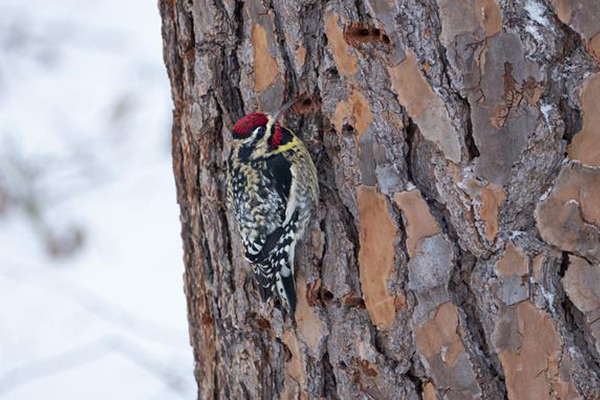
Yellow-bellied sapsucker threats
Yellow-bellied Sapsuckers are species of low concern. Their numbers have been shown to continuously increase from 1996 to 2014, thanks to the protection given to them. Before, they were shot the moment they were sighted in orchards. But now, many young forests are being grown, which has become very beneficial to these birds.
Yellow-bellied sapsucker fun & interesting facts
- Yellow-bellied Sapsuckers are the only migratory woodpecker in eastern North America.
- They make two kinds of holes in trees to harvest sap – round holes that they use to probe for sap and rectangular holes that must be maintained to allow the sap to flow continually.
- These birds have been found drilling sap wells in more than 1,000 species of trees and woody plants.
- These birds also use human-produced materials to help with territorial drumming.
- The oldest recorded Yellow-bellied Sapsucker was 7 years and 9 months old.
- Williamson’s Sapsucker
- Northern Flicker
- Red-naped Sapsucker
- Red-breasted Sapsucker
- Lewis’s Woodpecker
- Acron Woodpecker
- Gila Woodpecker
- Golden-fronted Woodpecker
- Red-bellied Woodpecker
- American Three-toed Woodpecker
- Black-beaded Woodpecker
- Downy Woodpecker
- Nuttall’s Woodpecker
- Red-headed Woodpecker
- Ladder-backed Woodpecker
- Hairy Woodpecker
- White-headed Woodpecker
- Arizona Woodpecker
- Ivory-billed Woodpecker
- Pileated Woodpecker
- Red-cockaded Woodpecker
- Gilded Flicker

